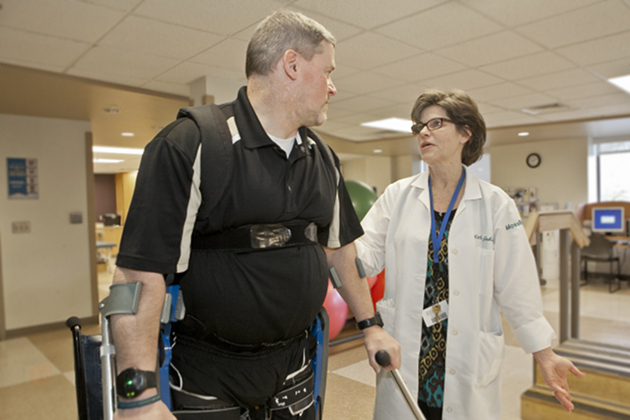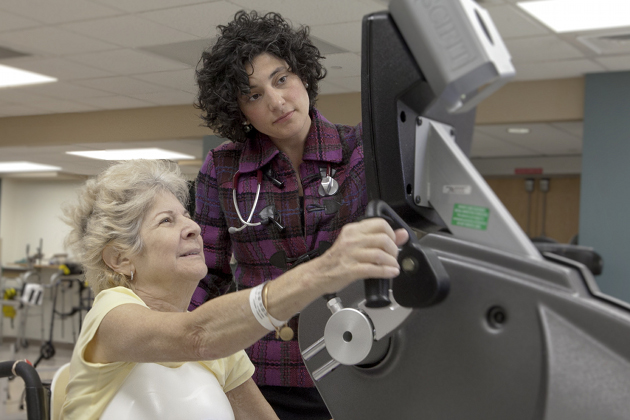New Inpatient and Outpatient Therapies Proving Restorative to SCI Patients
(Inside MossRehab - Winter 2014) - Significant advances in both technology and techniques are maximizing the physical, emotional, social and vocational capabilities of more than 250,000 Americans living with spinal cord injuries (SCI), and providing hope for an estimated 12,000 more who sustain these injuries annually. Now, new standards of care and advanced rehabilitation strategies employed at MossRehab soon after a patient sustains such an injury through the initial phases of rehabilitation and longer, are helping restore function in varying degrees to more SCI patients.
Acute therapies soon after injury
Once a spinal cord injury patient has been stabilized, the acute rehabilitation phase often sets the stage for the patient's continued recovery. During this phase, comprehensive care planning keeps one goal at the forefront: the patient's return home.
To get home, maintaining adequate nutrition and hydration is a primary medical need for all SCI patients. Patients with cervical level injuries, tracheostomy and other comorbid factors, have an increased risk of dysphagia, which can have devastating side effects, including aspiration pneumonia, if not properly diagnosed and treated. In addition, for SCI patients with dysphagia, the discomfort or difficulty swallowing challenges proper nutrition.

"By using fiberoptic endoscopic evaluation of swallowing (FEES) and vital stimulation therapy (VitalStim), dysphagia can be better diagnosed and therapeutically managed," says Beth Jacobs, RN, CCM, CRRN, clinical coordinator of the MossRehab Spinal Cord System of Care.
In FEES, a flexible fiberoptic endoscope is introduced transnasally to the patient's hypopharynx, and the ongoing examination is transmitted to a video screen. The patient is then led through various tasks to evaluate the sensory and motor status of the pharyngeal and laryngeal mechanism. Food and liquid boluses are given to the patient so that the integrity of the pharyngeal swallow can be determined. This examination shows the patient's ability to protect the airway, the ability to sustain this for a period of several seconds, and the ability to initiate a prompt swallow without spillage of material into the hypopharynx.
Based upon findings of FEES, the application of neuromuscular electrical stimulation to the swallowing muscles can be employed to treat dysphagia.
"With VitalStim, electricity stimulates inactive or atrophied swallowing muscles, with the goal of strengthening and re-educating the muscles and improving motor control of the swallowing mechanism," Jacobs explains.

Just as important as treating dysphagia in acute-stage SCI patients is addressing neurogenic bladder.
"We are focused on prevention of upper and lower tract complications at all stages of recovery, and especially early on," says Gina Benaquista DeSipio, DO, attending physician of spinal cord injury at MossRehab. "As soon as the patient is out of spinal shock we determine bladder and sphincter mechanism and discuss with patients their most appropriate bladder management options."
Once stabilized, preservation of renal function, freedom from urinary tract infection and efficient bladder emptying become the priority. Protocols can include administration of anticholinergic medication and training the patient in appropriate catheter technique.
"In the post-acute stages, urodynamic studies help to further evaluate bladder and sphincter function, measure leaking and voiding pressures, and identify issues that can lead to problems with bladder and renal function long term, "says Dr. Benaquista DeSipio.
Long-term urologic care for SCI patients is imperative as bladder mechanism changes over time, making regular and consistent evaluation and testing important. "We recommend yearly follow up with a SCI medicine specialist, urodynamic testing annually, renal ultrasounds when necessary and a renal scan every 10 years," explains Dr. Benaquista DeSipio. "My role is to help identify bladder management options that work with the patient's lifestyle, are the least invasive and the lowest risk, and take in to account SCI injury characteristics and change in bladder function over time."
The overall goal is to keep patients dry and keep voiding pressures low, which may require medications, bladder augmentation procedures or other interventions.
Another crucial aspect of SCI patient care is the prevention and treatment of pressure ulcers.
"The spinal cord injury population is the highest risk disability group for the development of pressure ulcers," says Jacobs. "Complications of pressure ulcers are very frequent because these patients are insensate and unable to mobilize themselves. We have developed a process for pressure ulcer prevention that is now the model for the entire MossRehab system."
The model involves an interdisciplinary approach to care, where a patient's care team performs rounds together to comprehensively evaluate a patient's risk of pressure ulcer by applying a standardized risk assessment. The results of that assessment then inform a therapeutic care plan.
"Some pressure ulcer care is highly routine, but by tailoring care to the specific patient risk profile, we are able to make big advances in the prevention of pressure ulcers," says Jacobs.
Leveraging neuroplasticity
While most recovery following SCI takes place within six months after injury, researchers and physiatrists at MossRehab continue to test ways to help restore function in patients with paralysis. Research suggests that the neuroplasticity of the central nervous system— its ability to reorganize itself by forming new neural connections—is retrained through intensive, repetitive movements. Such therapy can help the gradual reorganization of the brain and spinal cord, which subsequently allows the restoration of movement and function. Using robotics and gait training for people with incomplete spinal cord injury is proving successful at MossRehab, applying a highly intensive, individualized training program in a motivational environment of constant feedback.
MossRehab was the first in the Philadelphia region to offer therapy with a Lokomat, which helps strengthen and train impaired muscle groups to help the body relearn how to walk.
"We believe we are making a difference by providing patients, both inpatient and outpatient, robot-assisted body-weight-support locomotor training," says Harry Schwartz, MD, clinical director of spinal cord injury at MossRehab. Based on the theory that a central pattern generator (CPG) resides in the spinal cord and controls rhythmic locomotion patterns such as walking or running, repetitions of walking are believed to reactivate the CPG so the injured patient can re-learn the stepping mechanism. Patients whose joints are stable enough to limit the risk of knee hyperextension are ideal candidates for this therapy.
MossRehab provides gait training for patients using both the body-weight-supported treadmill training and robotic gait training with the Lokomat, a computer- controlled robotic exoskeleton. Lokomat and the G-EO System Evolution, a robotic walking training system, the patient expends. MossRehab was the first facility in the Philadelphia region to offer therapy with a Lokomat and the only one in the U.S. with a G-EO System Evolution. "Most of our inpatients who can benefit from locomotor therapy start with conventional therapy and are then introduced to the Lokomat," says Wesley Chay, MD, outpatient SCI physiatrist at MossRehab. "We have found that sensory-incomplete SCI patients who receive locomotor therapy also show significant improvement in cardiovascular and respiratory health, and reduction in secondary conditions including bowel incontinence and spasticity."
MossRehab also provides locomotor therapy for SCI patients on an outpatient basis, to help reduce the risk of osteoporosis.
"Within the first few years after spinal cord injury, bone mineral density can decrease upwards of 30 to 45 percent at the distal femur and 50 to 60 percent at the proximal tibia," says Dr. Chay. "As a result, patients with SCI not only have an increased risk of fractures, but also face significant morbidity and mortality associated with this risk. Locomotor therapy is an effective strategy to reduce the risk of osteoporosis."
Pain management
Spasticity and pain affect a majority of patients with spinal cord injury, most of whom require ongoing assessment and management to achieve optimal pain relief to enhance function and quality of life. Traditional therapies include non-pharmacologic measures, nerve blocks or injections of anesthetics, alcohol or phenol, or neurotoxins such as botulinum toxin, or oral medications. To overcome the side effects of some of these traditional therapies, spinal cord injury patients have another choice: an intrathecal pump.
Created to solve the problems and side effects of taking oral anti-spasticity medications, the pump system delivers drugs such as baclofen directly into the intrathecal space inside the spinal canal.
"Intrathecal baclofen therapy is one of the most important developments in the management of spastic hypertonia and other related features of upper motor neuron syndrome," says Michael Saulino, MD, PhD, clinical director of Intrathecal Therapy Services at MossRehab, who manages more than 400 baclofen pump patients, 100 of whom are SCI patients. "It has been successfully used to help SCI patients reduce impairments, relieve pain and improve function."
Intrathecal baclofen therapy delivers a precise and consistent drug dose throughout the day, helping patients avoid the peaks and valleys of taking oral medication while reducing adverse effects.
"The pump's programmability allows for an extraordinarily wide array of options for intrathecal delivery and the precision of this delivery cannot be obtained with any other method of spasticity management," says Dr. Saulino.
(See interview with Dr. Saulino)
In addition to managing spasticity and pain, MossRehab offers a plethora of community-based therapy programs that help re-engage the SCI patient into his or her community.
"A vital part of what we do is keep in mind what our SCI patients' lives were like before their injury, and work to get them back into their communities and able to independently undertake as many activities as possible," says Jacobs. "Our programs help them do the things they want to do – from shopping and getting onto a bus, to playing a sport and traveling."
Programs include personal fitness training, wheel chair dancing lessons, and a tri-state approved driving program. In addition, a unique partnership with Continental Airlines has helped people with SCI learn how to travel again.
Our "Project Airport program partnered with five of our patients who were brought to the airport and then exposed to all the realities of check-in, moving through security and navigating lines, as well as boarding the plane," Jacobs explained. "It was fulfilling to see these patients realize that they could gain back the independence travel has to offer."
(See related article: Practice Makes Perfect for High- Flying SCI Patients).
Applying six decades of experience to serve SCI patients
MossRehab offers a Commission for Accreditation of Rehabilitation Facilities (CARF) a CARF accredited personalized and comprehensive approach to spinal cord injury rehabilitation through a system of inpatient, outpatient, day hospital, day therapy and lifetime follow-up programs. Patients at various levels and severity of SCI as the result of both traumatic and non-traumatic spinal cord dysfunction benefit from an exceptional model of care that has been refined and developed during the past 60 years by MossRehab's distinguished physiatrists.
"What we do here for the SCI patient is very holistic," says Jacobs. "Our team is not just dedicated to delivering the best and most effective care for SCI patients, but we do so for their lifetime. They know we are here for them for the long-haul."